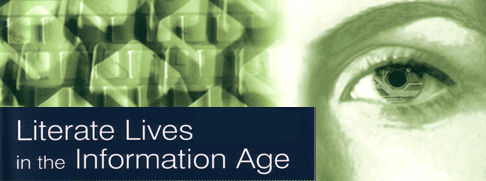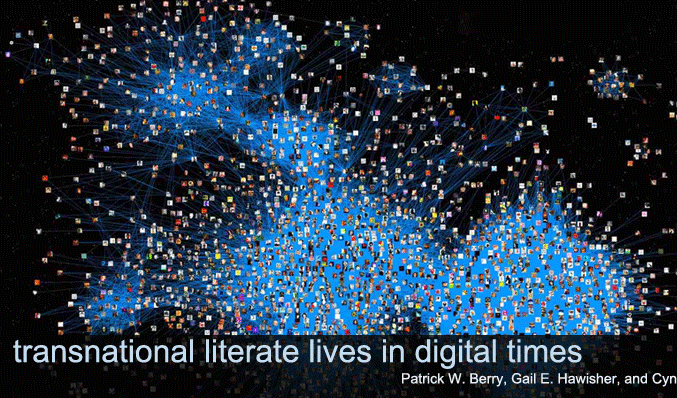INTRODUCTION: Goal of Project
The goal of this project is to understand the digital literacy practices of a generation of students with transnational connections. It both resembles and is different from earlier efforts to tell the literacy stories of individuals from the United States (e.g., Selfe & Hawisher, 2004).
As in the print book Literate Lives in the Information Age: Narratives of Literacy from the United States (2004), work on this project has sought ways to demonstrate the active agency of the participants with whom Selfe and Hawisher worked. All of the participants were asked to coauthor their chapters with us. We were influenced in this decision by Caroline Brettell's collection When They Read What We Write (1996), which presents a series of perspectives on studies like ours—anthropological projects, ethnographies, and life histories—and discusses the ways in which modernist approaches to such writing have often suffered due to the limited perspectives of academics and professional scholars.
Using texts such as John Van Maanen's Tales of the Field (1988) as her guide, Alexandra Jaffe (1996) argues that this approach to research claims a "distance between observer and observed" that is, to a great extent, an "ethnographic fiction," one that scholars have employed to "maintain control over…‘subjects’" (p. 51). As a corrective to this modernist approach, Brettell and others in her collection suggest the alternative method of having subjects “talk back” to (p. 9), comment on, modify, change, or correct scholars’ interpretations of what they've said. Their "talking back,” as Jaffe goes on to say, helps to “undermine” professional ethnographers’ “ability to construct an unproblematic other, and hence, an unproblematic self” (p. 52). In our experience, the reflexivity established by this dialogue is not only a positive and productive characteristic of postmodern anthropology but also, as Jaffe points out, a realistic and “essential condition of interaction with the people we study” (p. 51). We are proud to have the participants in our study as coauthors and have sought their responses to and input toward the work we present here.

Extending the Work of Selfe and Hawisher's Literate Lives in the Information Age
In this newest work, we also attempt to demonstrate an emerging research approach that recognizes issues of globalization while at the same time making use of digital tools to capture literate practices as represented to us by globally connected students and colleagues. In doing so, we sometimes employ digital media as research tools for collecting and exhibiting life history interviews, while at other times we ask students to represent their literate practices by videorecording their writing processes themselves. In the earlier Literate Lives (2004) study, the research itself was conducted with an eye toward presenting the analysis and interpretation of the material in print, not in the digital format now made possible through our work with Computers and Composition Digital Press.
In the material that follows—words, images, audio, video clips—we focus on the case studies of a group of people who acquired digital literacies as they were growing up and coming of age. We have selected 13 case studies from a larger population whom we have interviewed or who have replied in writing to a series of questions during the past several years. We recruited the participants in this project primarily through school settings, calling first on colleagues and students we knew in the United States, but also approaching students and colleagues whom we met on various research trips to countries such as China, Norway, Zimbabwe, Egypt, Australia, Great Britain, and Japan, among others. Several of the participants were students when we met them—undergraduate and graduate—but are now colleagues, and all are coauthors of the research presented here.
The 13 individuals whose stories constitute this particular part of our larger project ranged from 19 to 35 years of age when we met them and were brought up in or lived in multiple countries for extended periods of time: Australia, Bangladesh, Bosnia, Great Britain, Indonesia, Mexico, Nigeria, Norway, Peru, South Korea, and the United States. Some of the participants, along with other individuals inhabiting transnational contexts during the latter half of the 20th century and the first part of the 21st century, moved frequently from one area to another because of war, the quest for education, or the flow of global capitalism. Some of the participants grew up in relatively rural areas, several in good-sized towns, and others came of age and attended schools in large cities—Sydney, Lagos, Sarajevo, Lima, Oslo, Belgrade, and Puebla among them. Of the group, nine of the 13 participants represented are women, and the other four are men. At the time we first interviewed and worked with them, all had earned high school diplomas; seven had completed college, and those seven were enrolled in programs to earn master’s degrees or doctorates.
We have chosen to feature these particular 13 cases for several reasons. First, we think they provide an interesting set of cultural tracings—albeit fragmentary and incomplete—of how individuals inhabiting transnational contexts learn, take up, and use digital communication technologies to extend their communicative reach, to maintain their social and cultural identities, and to construct their worlds. As Carmen Luke (2001) points out, our understanding of globalized culture is only intelligible from a local perspective: “Globalization is as much about difference and ambivalence as it is about the sameness and similarities at the level of local uptakes, appropriations, identities, and engagements with global processes, structures, and ideologies” (p. 95). Literacy narratives and life history accounts, we believe, can help make some sense of these local uptakes because such portraits are so “deeply perspectival” and “inflected by the historical, linguistic, and political situatedness of different sorts of actors” (Appadurai, 1996, p. 33).
Second, because the participants largely grew up under markedly varied local circumstances, we believe that their narratives, along with some of the participants' writing process videos, can help readers further appreciate the importance of situating an understanding of digital literacies in specific cultural, material, educational, and familial contexts. For these 13 people, information and communication technologies represent a fundamental feature of a globalized world undergoing a period of major social, educational, and technological change, one in which people’s lives, and their literacies, have been altered in fundamental and specific ways. In this sense, the analyses provide some clues about the constellation of factors that can affect—and be affected by—digital literacy practices and values.
Building on the work in Literate Lives in the Information Age (2004), we call this interrelated set of factors the cultural ecology of literacy. With this term, we intend to signal the intimate relationship between literacy practices and values; educational practices and values; social formations of race, class, and gender; political and economic trends and events; family practices and experiences; and material conditions—among many other factors. As the work of Paul Kei Matsuda (2006), John Duffy (2007), Carmen and Allan Luke (2000), A. Suresh Canagarajah (2007), and Morris Young (2004) reminds us, we can understand transnational literacies, generally—and, we contend, digital literacies more specifically—only when they are properly situated within the context of a particular historical period, a particular cultural milieu, and a specific cluster of material conditions.
previous < > INTRODUCTION: Notes on Method















